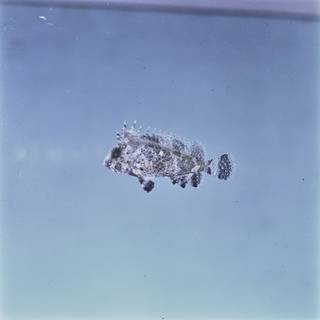Deep-Sea taxon details
Aploactinidae Jordan & Starks, 1904
- Genus Erisphex Jordan & Starks, 1904
- Genus Aploactoides Fowler, 1938 accepted as Erisphex Jordan & Starks, 1904
marine, terrestrial
Not documented
Distribution Western Pacific and Indian Ocean, mostly in the Indonesian and Australian regions. Body usually velvety due to modified,...
Distribution Western Pacific and Indian Ocean, mostly in the Indonesian and Australian regions. Body usually velvety due to modified, prickly scales. With knoblike spines on head. Unbranched fin rays. Anal fin spines usually not distinct or lacking. Dorsal fin origin above eye or almost so, except in the genera Adventor and Peristrominous. First 3-5 dorsal fin spines usually appear segregated, either elevated or largely without membrane connection with the rest of the spinous dorsal. The first 3 or 4 spines form a separate fin in four species. Pelvic fin with less than 4 soft rays. Anterior isthmus with fleshy extension in most species. No palatine teeth. No gill slit behind the last arch. [details]
Froese, R. and D. Pauly. Editors. (2024). FishBase. Aploactinidae Jordan & Starks, 1904. Accessed through: Glover, A.G.; Higgs, N.; Horton, T. (2024) World Register of Deep-Sea species (WoRDSS) at: https://www.marinespecies.org/deepsea/aphia.php?p=taxdetails&id=154253 on 2025-03-30
Glover, A.G.; Higgs, N.; Horton, T. (2025). World Register of Deep-Sea species (WoRDSS). Aploactinidae Jordan & Starks, 1904. Accessed at: https://www.marinespecies.org/Deepsea/aphia.php?p=taxdetails&id=154253 on 2025-03-30
Date
action
by
taxonomy source
Van Der Laan, R.; Eschmeyer, W. N.; Fricke, R. (2014). Family-group names of Recent fishes. <em>Zootaxa.</em> 3882(1): 1-230., available online at https://doi.org/10.11646/zootaxa.3882.1.1 [details] Available for editors 
basis of record Fricke, R., Eschmeyer, W. N. & Van der Laan, R. (eds). (2025). ECoF. Eschmeyer's Catalog of Fishes: Genera, Species, References. <em>California Academy of Sciences. San Francisco.</em> Electronic version accessed dd mmm 2025., available online at http://researcharchive.calacademy.org/research/Ichthyology/catalog/fishcatmain.asp [details]
basis of record Fricke, R., Eschmeyer, W. N. & Van der Laan, R. (eds). (2025). ECoF. Eschmeyer's Catalog of Fishes: Genera, Species, References. <em>California Academy of Sciences. San Francisco.</em> Electronic version accessed dd mmm 2025., available online at http://researcharchive.calacademy.org/research/Ichthyology/catalog/fishcatmain.asp [details]
 Present
Present  Inaccurate
Inaccurate  Introduced: alien
Introduced: alien  Containing type locality
Containing type locality
Unreviewed
Distribution Western Pacific and Indian Ocean, mostly in the Indonesian and Australian regions. Body usually velvety due to modified, prickly scales. With knoblike spines on head. Unbranched fin rays. Anal fin spines usually not distinct or lacking. Dorsal fin origin above eye or almost so, except in the genera Adventor and Peristrominous. First 3-5 dorsal fin spines usually appear segregated, either elevated or largely without membrane connection with the rest of the spinous dorsal. The first 3 or 4 spines form a separate fin in four species. Pelvic fin with less than 4 soft rays. Anterior isthmus with fleshy extension in most species. No palatine teeth. No gill slit behind the last arch. [details]Habitat Coastal [details]

